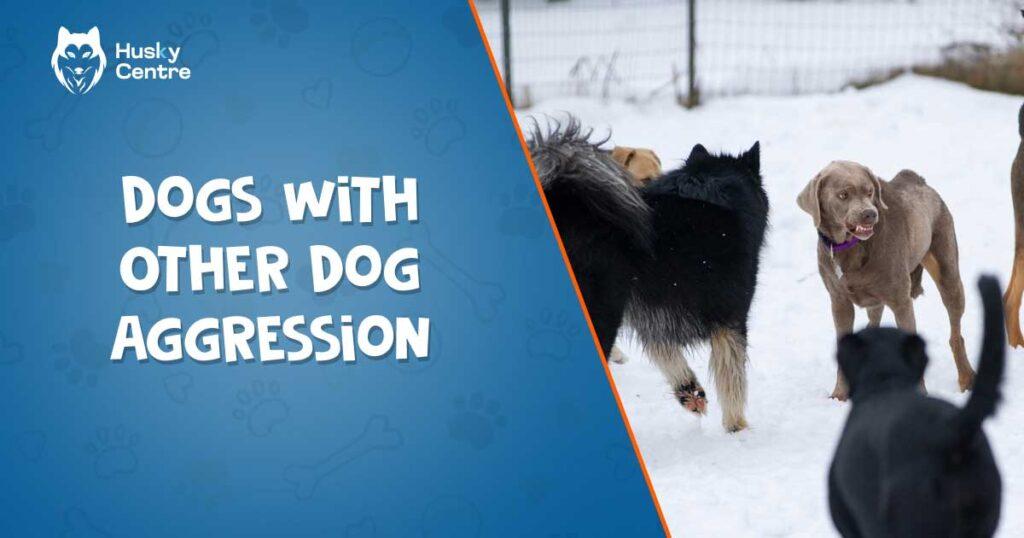Dog aggression towards other dogs can stem from fear, lack of socialization, or dominance issues. Solutions include training, socialization, and professional help.
Dog aggression towards other dogs is a common issue faced by many pet owners. Understanding the root causes is crucial for effective management. Aggression can arise from fear, territorial instincts, or a lack of proper socialization. Early intervention and consistent training play vital roles in curbing this behavior.
Socialization is key, exposing your dog to different environments and other dogs in a controlled manner. Seeking professional help from a qualified dog trainer or behaviorist can provide tailored strategies. With patience and the right approach, you can help your dog develop better interactions with other dogs.
Common Causes Of Dog Aggression Toward Other Dogs
Understanding dog behavior is crucial for addressing dog aggression toward other dogs. Various factors can trigger this behavior, and identifying the causes helps in finding effective solutions. This section delves into the common causes of dog aggression toward other dogs, offering insights into why dogs may exhibit aggressive tendencies.
Reasons For Aggression
There are several dog aggression reasons. Recognizing these helps in addressing the underlying issues. Some common reasons include:
- Territorial behavior: Dogs may become aggressive when they feel their space is invaded.
- Fear: Fearful dogs often react aggressively to protect themselves.
- Lack of socialization: Dogs not exposed to other dogs may exhibit aggression.
- Past experiences: Negative encounters with other dogs can lead to aggression.
- Individual temperament: Some dogs have a naturally more aggressive temperament.
Understanding these reasons allows pet owners to take appropriate steps to mitigate aggressive behavior. Dog behavior problems can often be managed or resolved by addressing the root cause.
Territorial Behavior, Fear, And Lack Of Socialization
Territorial behavior is a significant cause of dog aggression. Dogs are naturally territorial and may become aggressive to defend their space. This behavior is more pronounced in their home environment or familiar territory.
Fear is another common cause. A dog may react aggressively out of fear, especially if it feels threatened. Fearful dogs often have a history of abuse, neglect, or lack of positive experiences.
Lack of socialization plays a crucial role. Dogs not exposed to other dogs during their critical socialization period are more likely to exhibit aggression. Socialization helps dogs learn how to interact positively with their peers.
| Cause | Description |
|---|---|
| Territorial behavior | Defending their space from perceived threats |
| Fear | Reacting aggressively to protect themselves |
| Lack of socialization | Not exposed to other dogs during critical periods |
Breed Tendencies
Breed tendencies can also influence dog aggression. Some breeds are naturally more territorial or protective, while others may have a lower threshold for aggression. Understanding your dog’s breed characteristics can help in managing their behavior.
For example, breeds like Rottweilers and German Shepherds are known for their protective instincts. While these traits can be beneficial, they can also lead to aggressive behavior if not properly managed. On the other hand, breeds like Labradors are typically more social and less prone to aggression.
Here is a table highlighting some breed tendencies:
| Breed | Tendency |
|---|---|
| Rottweiler | Protective, territorial |
| German Shepherd | Protective, loyal |
| Labrador | Social, friendly |
Past Experiences
Past experiences significantly impact a dog’s behavior. Dogs with a history of negative encounters with other dogs may develop aggressive tendencies. This could be due to attacks, fights, or even consistent bullying by other dogs.
Positive past experiences help in shaping a dog’s friendly behavior. Conversely, negative experiences lead to fear and aggression. Dogs remember these encounters and may react aggressively to prevent a repeat incident.
Here are some examples of past experiences that can lead to aggression:
- Attacks: Being attacked by another dog
- Fights: Getting involved in frequent fights
- Bullying: Being bullied by other dogs
Addressing past traumas with positive reinforcement and training can help mitigate aggressive behavior.
Individual Temperament Contribute
Individual temperament plays a crucial role in dog aggression. Every dog has a unique personality, and some are naturally more aggressive. This could be due to genetics or inherent characteristics.
For example, some dogs are naturally more dominant, while others are more submissive. Dominant dogs may exhibit aggression to assert their dominance, while submissive dogs may do so out of fear.
Here are some factors contributing to individual temperament:
- Genetics: Inherited traits from parent dogs
- Personality: Natural disposition and characteristics
- Environmental factors: Living conditions and upbringing
Understanding your dog’s temperament helps in tailoring training and behavior modification techniques effectively.
Signs Of Dog-to-dog Aggression
Understanding dog-to-dog aggression is crucial for any dog owner. Recognizing the signs of dog aggression early can help prevent conflicts and ensure a peaceful environment. This section will delve into the specific signs of dog-to-dog aggression.
How To Recognize Early Signs Of Aggression
Recognizing aggressive behavior in dogs early can save a lot of trouble. Early signs of aggression are subtle but noticeable if you pay attention. Dogs may exhibit certain behaviors that indicate discomfort or the potential for aggression.
- Stiff body posture: A dog that stands rigidly is often feeling threatened.
- Direct eye contact: Prolonged staring can be a precursor to aggressive behavior.
- Raised hackles: The fur on the dog’s back and neck stands up when they feel threatened.
- Growling: This is a clear sign that a dog is unhappy and may escalate to aggression.
These early signs should not be ignored. If you observe these behaviors, it’s important to intervene before the situation escalates. Providing distractions or redirecting attention can help diffuse potential conflicts.
| Behavior | What It Means |
|---|---|
| Stiff body posture | Feeling threatened |
| Direct eye contact | Potential aggression |
| Raised hackles | Feeling threatened |
| Growling | Unhappiness, potential aggression |
Observing Body Language And Vocal Cues
Dog body language and vocal cues are essential in recognizing dog aggression signs. Observing these cues can help you understand your dog’s mood and intentions. Dogs communicate a lot through their body language.
Body Language:
- Tail Position: A high, stiff tail can indicate aggression, while a tucked tail shows fear.
- Ears: Ears pinned back or erect can signal different emotions. Pinned back ears often indicate fear, while erect ears show alertness or aggression.
- Mouth: Snarling, showing teeth, or excessive licking can be signs of stress or aggression.
Vocal Cues:
- Barking: Continuous barking can signal distress or a warning.
- Whining: This can indicate anxiety or discomfort.
- Growling: As mentioned earlier, growling is a direct indication of potential aggression.
Understanding these signs can help you intervene before conflicts arise. Recognizing aggressive behavior early ensures the safety and well-being of your dog and others.
Tips For Managing And Reducing Dog Aggression
Dogs With Other Dog Aggression can be challenging for pet owners. Understanding the causes and solutions is key to creating a peaceful home. This section provides practical Tips for Managing and Reducing Dog Aggression. Proper strategies and expert help can make a big difference in managing dog behavior effectively.
Strategies For Managing Aggression
Managing dog aggression requires consistency and patience. Here are some effective strategies:
- Identify triggers: Observe what causes aggression in your dog. It could be certain dogs, environments, or situations.
- Positive reinforcement: Reward your dog for calm behavior around other dogs. Use treats, praise, or toys.
- Desensitization: Gradually expose your dog to other dogs at a safe distance. Increase exposure slowly as your dog becomes more comfortable.
- Leash training: Teach your dog to walk calmly on a leash. Use a harness if necessary to control strong dogs.
| Strategy | Description |
|---|---|
| Identify triggers | Find out what makes your dog aggressive |
| Positive reinforcement | Reward calm behavior |
| Desensitization | Gradually expose to triggers |
| Leash training | Teach calm walking on a leash |
Reducing dog aggression often involves consistent training. Practice these strategies daily to see improvements. In addition, ensure your dog gets enough exercise and mental stimulation. A tired dog is less likely to exhibit aggressive behavior.
Seek Help From A Behaviorist Or Trainer
Sometimes, managing dog behavior requires professional assistance. Here’s why you should consider a behaviorist or trainer:
- Expertise: They have specialized knowledge in dog training for aggression.
- Customized plans: Professionals create tailored plans for your dog’s specific needs.
- Support and guidance: They provide ongoing support to ensure progress.
Finding the right professional is crucial. Look for someone with certifications and good reviews. You can start by asking your vet for recommendations. Additionally, check organizations like the International Association of Animal Behavior Consultants (IAABC).
Here’s a simple table to help you choose a professional:
| Criteria | What to Look For |
|---|---|
| Certifications | Certified behaviorist or trainer |
| Experience | Years of working with aggressive dogs |
| Reviews | Positive feedback from other dog owners |
| Approach | Uses positive reinforcement techniques |
Professional help can make a significant difference in reducing dog aggression. It provides you with the tools and knowledge needed for managing and training your aggressive dog effectively.
Frequently Asked Questions
What Causes Dogs To Be Aggressive Towards Other Dogs?
Dog aggression towards other dogs can stem from fear, territorial behavior, or lack of socialization. It’s important to identify the root cause.
How Can I Prevent Dog Aggression?
Prevent dog aggression by socializing your dog early, using positive reinforcement, and consulting a professional trainer if needed.
Are Certain Breeds More Prone To Aggression?
Some breeds may be more prone due to genetics, but individual behavior varies. Training and socialization are key.
Can Training Help With Dog Aggression?
Yes, training can help manage and reduce dog aggression. Consistency and positive reinforcement are crucial.
Conclusion
Understanding dog aggression helps improve your pet’s behavior. Identify triggers and use positive reinforcement. Patience and consistency are key. Seek professional help if needed. Create a peaceful environment for your dog. Harmony with other dogs is achievable with effort and care.
Your furry friend deserves a happy, balanced life.


Meet Jarred, the heart and soul behind HukyCentre. With a deep affection for furry friends, he pours his passion into every word he writes. His genuine love for dogs shines through in his engaging and informative content. As a dedicated dog enthusiast, Jarred’s goal is to share valuable insights and tips that resonate with fellow dog lovers. Join Jarred on the journey as he celebrates the joy and companionship that dogs bring into our lives.



